1995 CHEVROLET TAHOE light
[x] Cancel search: lightPage 83 of 486
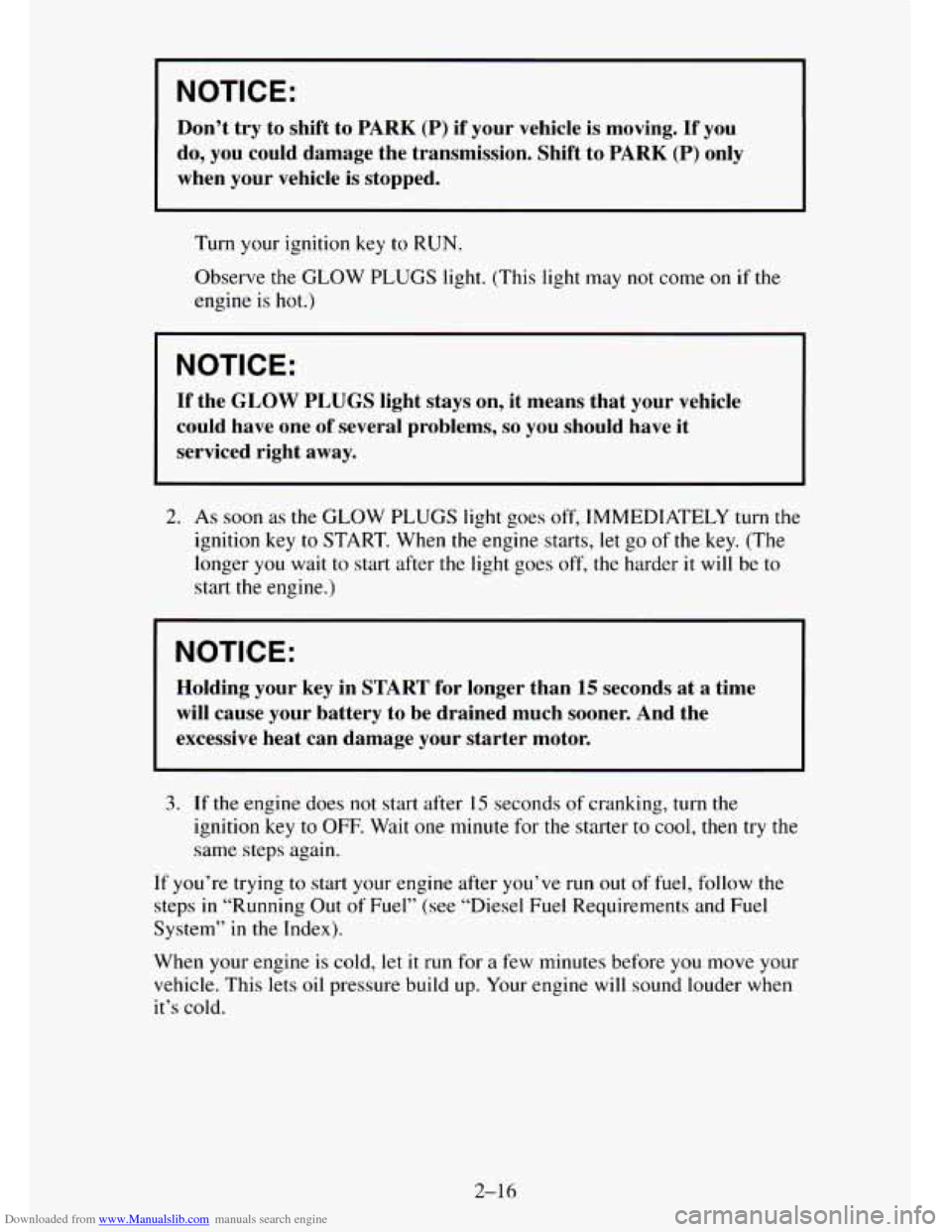
Downloaded from www.Manualslib.com manuals search engine NOTICE:
Don’t try to shift to PARK (P) if your vehicle is moving. If you
do, you could damage the transmission. Shift to PARK
(P) only
when your vehicle is stopped.
Turn your ignition
key to RUN.
Observe the GLOW PLUGS light. (This light may not come on if the
engine is hot.)
NOTICE:
If the GLOW PLUGS light stays on, it means that your vehicle
could have one
of several problems, so you should have it
serviced right
away.
2. As soon as the GLOW PLUGS light goes off, IMMEDIATELY turn the
ignition key to START. When the engine starts, let go of the key. (The
longer you wait to start after the light goes off, the harder it will be to
start the engine.)
NOTICE:
Holding your key in START for longer than 15 seconds at a time
will cause your battery to be drained much sooner. And the
excessive heat can damage your starter motor.
3. If the engine does not start after 15 seconds of cranking, turn the
ignition key
to OFF. Wait one minute for the starter to cool, then try the
same steps again.
If you’re trying to start your engine after you’ve run out of fuel, follow the
steps
in “Running Out of Fuel” (see “Diesel Fuel Requirements and Fuel
System”
in the Index).
When your engine is cold, let it
run for a few minutes before you move your
vehicle. This lets oil pressure build up. Your engine will sound louder when
it’s cold.
2-16
Page 85 of 486

Downloaded from www.Manualslib.com manuals search engine How long should you keep the coolant heater plugged in? The answer
depends
on the weather, the kind of oil you have, and some other things.
Follow this chart.
Viscosity/
Oil Grade
SAE
low-30
SAE
15W40
32°F to 0°F
(OOC to -18OC)
Not
Required
Not
Required
0°F to -10°F
(-18” c to
-23 O C)
Two
Hours*
Two
Hours*
Below -10°F
Below
-23 O C
Eight Hours*
or Overnight
Eight Hours*
or Overnight
*The times listed are minimum times.
It will not harm either the coolant
heater or
the vehicle to leave the coolant heater plugged in longer than the
times stated.
See “Diesel Fuel Requirements and
Fuel System” in the Index for
information
on what fuel to use in cold weather.
lf Your Diesel Engine Won’t Start
If you’ve run out of fuel, look at “Running Out of Fuel” (see “Diesel Fuel
Requirements and Fuel System” in the Index).
If you’re
not out of fuel, and your engine won’t start, do this:
Turn your ignition
key to RUN. Make sure that the GLOW PLUGS light is
out. Then IMMEDIATELY
turn the ignition key to START.
If the light doesn’t go off, wait a few seconds, then try starting your engine
again. And, see your dealer
as soon as you can for a starting system check.
If the light comes
on and then goes off and you know your batteries are
charged, but your engine still
won’t start, your vehicle needs service.
If the light does
not come on when the engine is cold, your vehicle needs
service.
If your batteries don’t have enough charge to start your engine, see
“Battery”
in the Index.
Be sure you have the right oil for your engine, and that you’ve changed
the
oil at the proper times. If you use the wrong oil, your engine may be harder
to start.
If the engine starts, runs a short time, then stops, your vehicle needs service.
2-18
Page 91 of 486
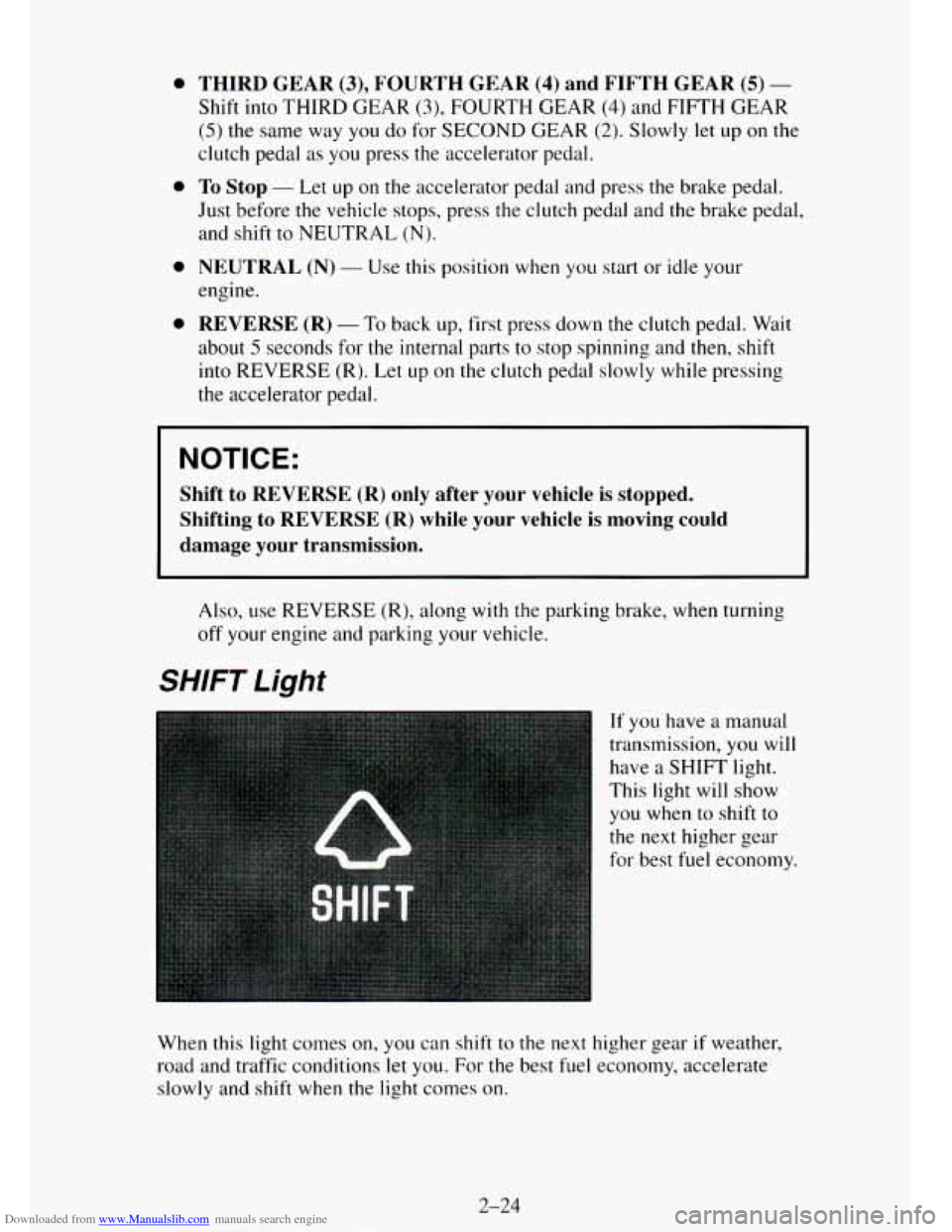
Downloaded from www.Manualslib.com manuals search engine 0
0
0
0
THIRD GEAR (3), FOURTH GEAR (4) and FIFTH GEAR (5) -
Shift into THIRD GEAR (3), FOURTH GEAR (4) and FIFTH GEAR
(5) the same way you do for SECOND GEAR (2). Slowly let up on the
clutch pedal
as you press the accelerator pedal.
To Stop - Let up on the accelerator pedal and press the brake pedal.
Just before the vehicle stops, press the clutch pedal and the brake pedal,
and shift to NEUTRAL
(N).
NEUTRAL (N) - Use this position when you start or idle your
engine.
REVERSE (R) - To back up, first press down the clutch pedal. Wait
about
5 seconds for the internal parts to stop spinning and then, shift
into REVERSE (R). Let up on the clutch pedal slowly while pressing
the accelerator pedal.
NOTICE:
Shift to REVERSE (R) only after your vehicle is stopped.
Shifting to REVERSE
(R) while your vehicle is moving could
damage your transmission.
Also, use REVERSE (R), along with the parking brake, when turning
off your engine and parking your vehicle.
SHIFT Light
If you have a manual
transmission, you will
have a
SHIFT light.
This light will show
you when to shift to
the
next higher gear
for best fuel economy.
When
this light comes on, you can shift to the next higher gear if weather,
road and traffic conditions let you.
For the best fuel economy, accelerate
slowly and shift when the light comes on.
2-24
Page 92 of 486

Downloaded from www.Manualslib.com manuals search engine While you accelerate, it is normal for the light to go on and off if you
quickly change
the position of the accelerator. Ignore the SHIFT light when
you downshift.
Four-Wheel-Drive Vehicles Only: If your vehicle has four-wheel drive
and
is equipped with a manual transmission, disregard the SHIFT light
when the transfer case
is in 4-LOW.
Manual Transmission Shift Speeds
If your speed drops below 20 mph (32 km/h), or if the engine is not running
smoothly,
you should downshift to the next lower gear. You may have to
downshift two or more gears
to keep the engine running smoothly or for
good performance.
A CAUTION:
If you skip more ;than one gear when you downshift, you could
lose control of your vehicle. And you could injure yourself or
others. Don’t shift down more than one gear when you
downshift.
NOTICE:
If you skip more than one gear when you downshift, or if you
race the engine when you downshift, you can damage the engine,
clutch or transmission.
Locking Rear Axle
If you have this feature, your rear axle can give you additional traction on
snow, mud, ice, sand or gravel. It works like a standard axle most of the
time, but when
one of the rear wheels has no traction and the other does, the
locking feature will allow the wheel with traction to move the vehicle.
2-25
Page 93 of 486
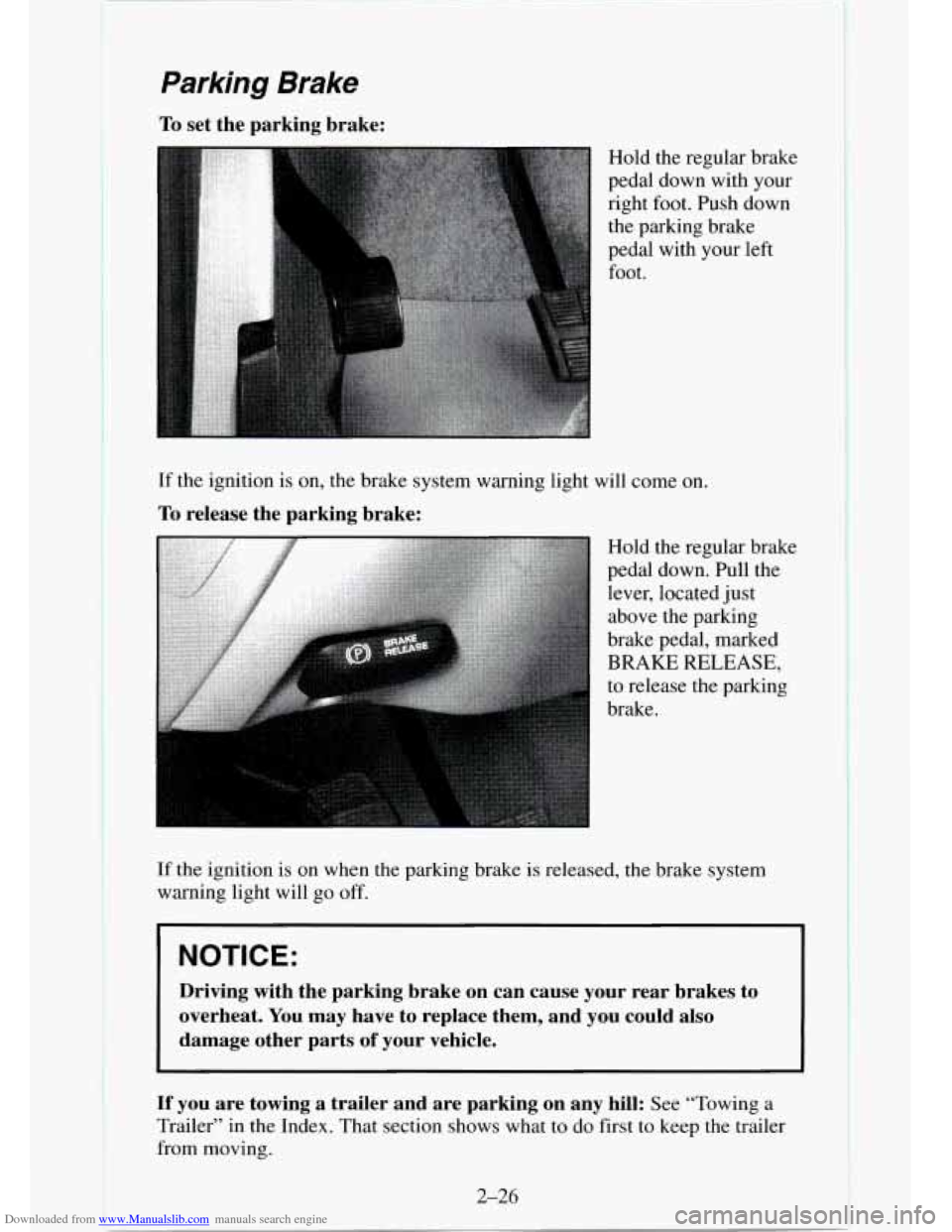
Downloaded from www.Manualslib.com manuals search engine Parking Brake
To set the parking brake:
Hold the regular brake
pedal down with your
right foot. Push down
the parking brake
pedal with your left
foot.
If the ignition is on, the brake system warning light will come on.
To release the parking brake:
Hold the regular brake
pedal down. Pull the
lever, located just
above the parking
brake pedal, marked
BRAKE RELEASE,
to release the parking
brake.
If the ignition is on when the parking brake is released, the brake system
warning light will
go off.
I NOTICE:
Driving with the parking brake on can cause your rear brakes to
overheat. You may have to replace them, and you could also
damage other parts
of your vehicle.
If you are towing a trailer and are parking on any hill: See “Towing a
Trailer” in the Index. That section shows what to do first to keep the trailer
from moving.
2-26
I I
Page 101 of 486
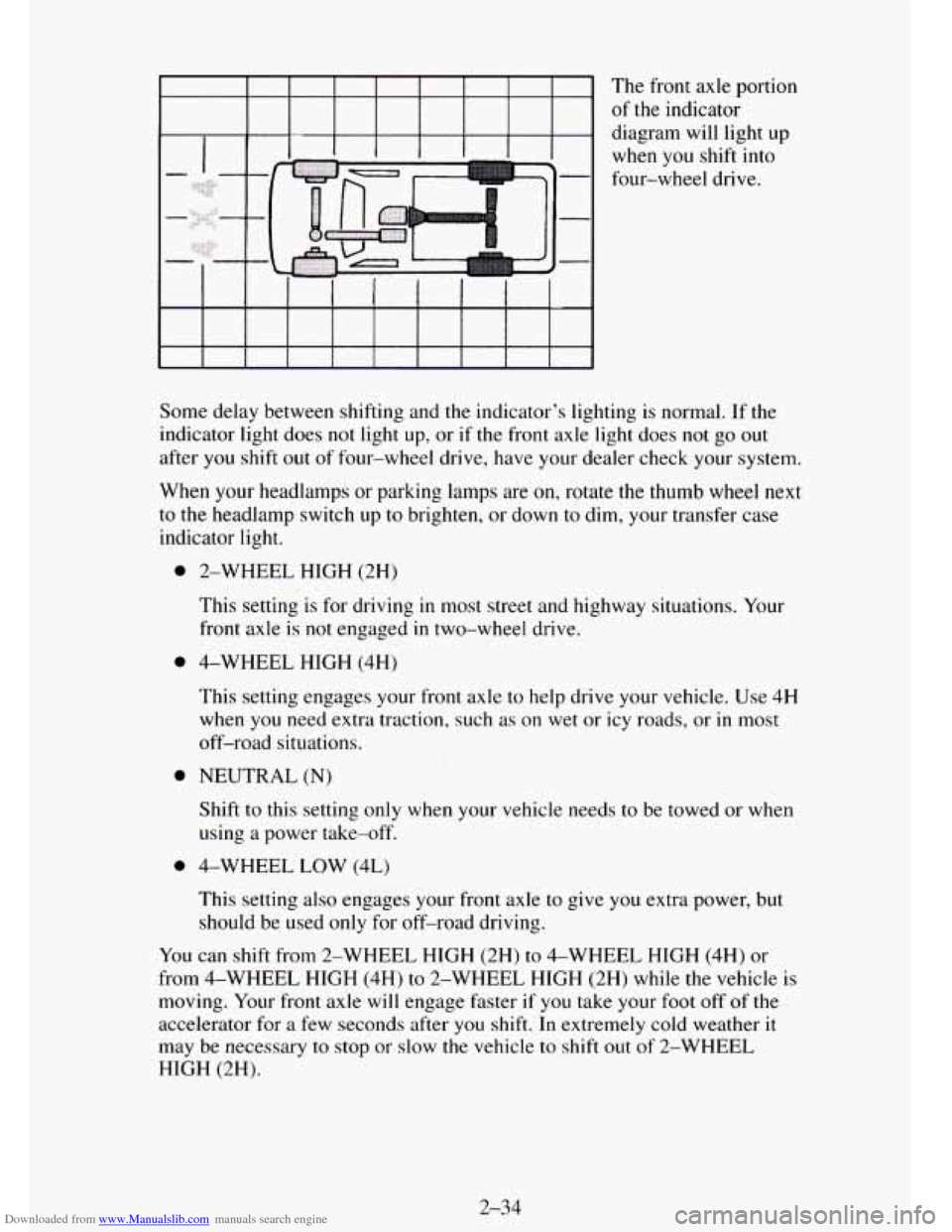
Downloaded from www.Manualslib.com manuals search engine The front axle portion
of
the indicator
diagram will light up
when you shift into
four-wheel drive.
Some delay between shifting and the indicator's lighting is normal.
If the
indicator light does
not light up, or if the front axle light does not go out
after you shift out of four-wheel drive, have your dealer check your system.
When your headlamps or parking lamps are
on, rotate the thumb wheel next
to the headlamp switch up to brighten, or down to dim, your transfer case
indicator light.
0
0
0
0
2-WHEEL HIGH (2H)
This setting
is for driving in most street and highway situations. Your
front axle
is not engaged in two-wheel drive.
4-WHEEL HIGH (4H)
This setting engages your front axle to help drive your vehicle. Use 4H
when
you need extra traction, such as on wet or icy roads, or in most
off-road situations.
NEUTRAL
(N)
Shift to this setting only when your vehicle needs to be towed or when
using
a power take-off.
4-WHEEL LOW (4L)
This setting
also engages your front axle to give you extra power, but
should be used only for off-road driving.
You can shift from 2-WHEEL HIGH (2H) to 4-WHEEL HIGH (4H) or
from 4-WHEEL HIGH (4H) to 2-WHEEL HIGH (2H) while the vehicle
is
moving. Your front axle will engage faster if you take your foot off of the
accelerator for
a few seconds after you shift. In extremely cold weather it
may be necessary to stop or slow the vehicle to shift out of 2-WHEEL
HIGH (2H).
2-34
Page 102 of 486
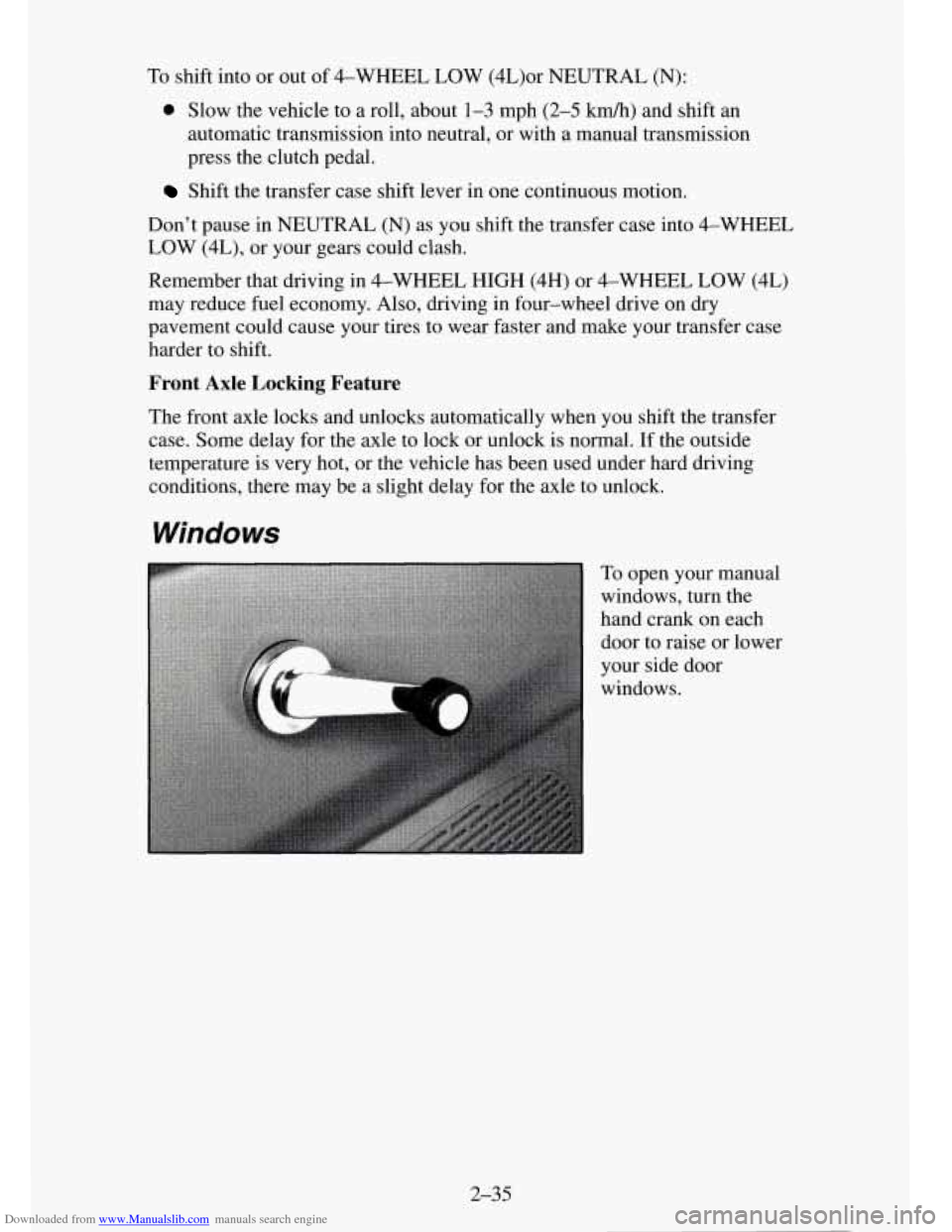
Downloaded from www.Manualslib.com manuals search engine To shift into or out of 4-WHEEL LOW (4L)or NEUTRAL (N):
0 Slow the vehicle to a roll, about 1-3 mph (2-5 kdh) and shift an
automatic transmission into neutral, or with a manual transmission
press the clutch pedal.
Shift the transfer case shift lever in one continuous motion.
Don’t pause in NEUTRAL
(N) as you shift the transfer case into 4-WHEEL
LOW (4L), or your gears could clash.
Remember that driving in 4-WHEEL HIGH (4H) or 4-WHEEL LOW (4L)
may reduce fuel economy. Also, driving in four-wheel drive on dry
pavement could cause your tires to wear faster and make your transfer case
harder
to shift.
Front Axle Locking Feature
I ne front axle locks and unlocks automatically when you shift the transfer
case. Some delay for the axle to lock or unlock is normal. If the outside
temperature is very hot, or the vehicle has been used under hard driving
conditions, there may be a slight delay for the axle to unlock.
Windows
To open your manual
windows, turn the
hand crank on each
door to raise or lower
your side door
windows.
2-35
Page 103 of 486
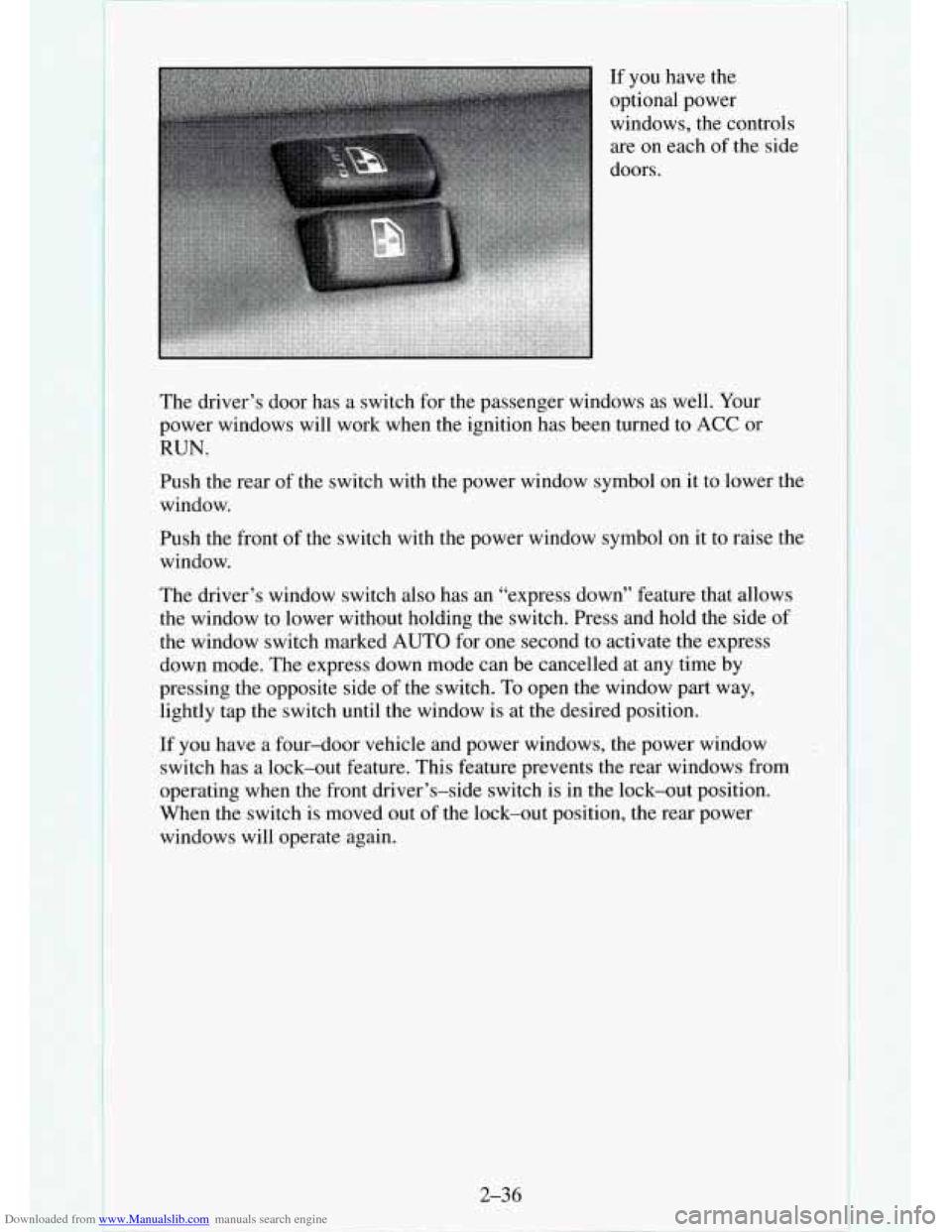
Downloaded from www.Manualslib.com manuals search engine The driver’s door has a switch for the passenger windows as well. Your
power windows will work when the ignition has been turned to
ACC or
RUN.
Push the rear of the switch with the power window symbol on it to lower the
window.
Push the front of the switch with the power window symbol on
it to raise the
window.
The driver’s window switch also has an “express down” feature that allows
the window to lower without holding the switch. Press and hold the side
of
the window switch marked AUTO for one second to activate the express
down mode. The express down mode can be cancelled at any time by
pressing the opposite side
of the switch. To open the window part way,
lightly tap the switch until the window is at the desired position.
If you have a four-door vehicle and power windows, the power window
switch has a lock-out feature. This feature prevents the rear windows from
operating when the front driver’s-side switch
is in the lock-out position.
When the switch is moved
out of the lock-out position, the rear power
windows will operate again.
2-36
I